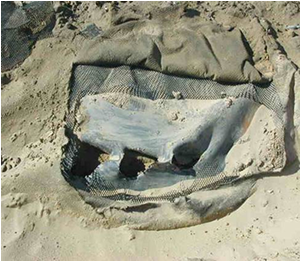This article is the second in a planned series of primers on geoelectric leak location technologies with geosynthetic barrier systems, relevant applications, affiliated issues from the field, and more. You can read the first article here. – Chris Kelsey, Editor, Geosynthetica
**
 |
Recently we have heard of geoelectric surveys being required on a double geomembrane liner with a geonet leak detection system (LDS) where the leak was suspected to be on the side slope. This was a sizeable evaporation pond with 6 ft. of water and a leak flow rate of about 25 gallons per week.
Per week, not per day!
This is a miniscule leak and not worth worrying about. Any activity on the liner to find and repair this leak will almost assuredly result in a higher leak rate due to collateral damage. And the only way to do a survey would be to backfill the LDS with water–which would only cover part of the floor while also presenting the possibility of inducing further damage.
Some leak scenarios should not be tested.
In another case the same volumetric leak flow rate specified for a small shallow pond was applied to a 70 acre, 50 ft. deep pond. This rate was lower than the water vapor transmission rate through the liner without any holes! The owner had spent several hundred thousand dollars trying to find a leak.
Some lining systems cannot be tested electrically.
Here is a quick overview of what you should think about when designing a lining system that will need a survey, or when determining if a survey can be successful on an in-service system:
|
Design Criteria for a Surveyable Lining System 1. There must be a conductive medium above the geomembrane 2. There must be a conductive pathway from the current injector electrode placed in the liquid/soil through all the layers on top of the geomembrane to any hole in the geomembrane. That is through the soil, a separation geotextile, a gravel drainage layer, a geocomposite, and other layer that might be present, to the hole. If the geocomposite is new and dry it may not be conductive. 3. There must be a conductive medium through the holes being sought. If there is a bubble in the hole, or a cavity under the hole there will not be a conductive pathway. 4. There must be a conductive pathway under the geomembrane from any hole to wherever the current return electrode is placed — in soil outside the liner, in the secondary sump, etc. This means through a GCL, through a geocomposite, a gravel drainage layer, and any subgrade soil. If the installation is new and the GCL and geocomposite are dry there may not be a conductive pathway. Consider irrigation during installation. Thus a double geomembrane with a geocomposite (nonconductive) LDS cannot be surveyed. 5. There should be no contact between media above and below the liner other than through the holes being sought. Thus a soil covered single liner where cover soil is in contact with subgrade soil cannot be effectively surveyed. However, we are getting close to being able to do that. 6. If it rains on a liner with exposed side slopes this contravenes item 5 above 7. Metal pipes will appear as large leaks and may prevent detection of nearby liner leaks. 8. Concrete structures and metal batten strips will appear as large leaks and may prevent detection of nearby leaks in the geomembrane. |
Remember, if conditions are not appropriate there will be no leaks indicated. The installation will look great, but you will probably have missed leaks.
Reference ASTM standards are D6747 (general guide), 7002 (exposed liner — water puddle) 7007 (soil and liquid covered liners), 7240 (conductive geomembrane). Soon, one more on the water lance for exposed liners will be available.
Ian Peggs is the president of I-CORP INTERNATIONAL, Inc. He can be reached at icorp@geosynthetic.com.











